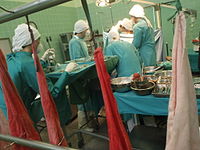
Photo from wikipedia
For over 30 years, our TE has processed, controlled for quality and distributed cryopreserved allograft valves for human application. We present a review of this activity and future perspectives of… Click to show full abstract
For over 30 years, our TE has processed, controlled for quality and distributed cryopreserved allograft valves for human application. We present a review of this activity and future perspectives of cardiovascular tissue banking. The donor age and medical/behavioral history are in compliance with the regulations of the EUMS. Allograft morphology and function are evaluated in a class A cleanroom. Tests for viral/bacterial infection, histological control of structure/infection/malignancy and control-rate cryopreservation are performed. A total of 7562 hearts were sent to our TE, whereas 7290 valves (pulmonary, aortic and mitral) were transplanted. The donations increased over time: 1934, 2566 and 3062 hearts were donated during the first, second and third decades (increases of 32.7 and 19.3% during the second and third decades). Likewise, there was a significant increase in transplantations with 2050, 2550 and 2690 valves implanted during the first, second and third decades (24.4 and 5.5% increase during the second and third decades). A total of 4475 pulmonary (61.4%), 2760 aortic (37.9%) and 55 mitral valves (0.7%) were transplanted. Outstanding long-term results in adults and evidence of immune-related deterioration of allografts in neonates and infants were demonstrated. Decellularization was suggested as a solution. One hundred pulmonary and 180 aortic valves were sent for transplantation after decellularization for the ESPOIR and ARISE clinical trials and beyond. The donation and transplantation activity increased progressively. Although cryopreserved valves represent the best substitute for diseased valves, accelerated failure appears after implantation in neonates and infants. The implementation of new technologies, such as decellularization, as a standard procedure for treatment of allograft valves will offer further improvements in allograft quality and increase of durability.
Journal Title: Cell and Tissue Banking
Year Published: 2021
Link to full text (if available)
Share on Social Media: Sign Up to like & get
recommendations!